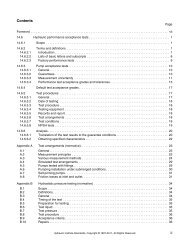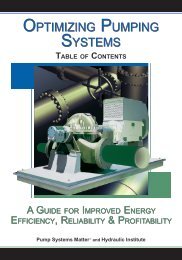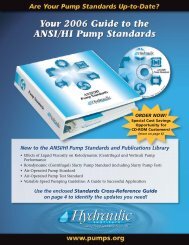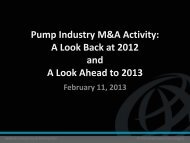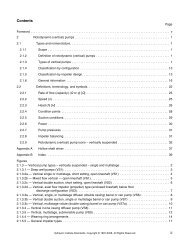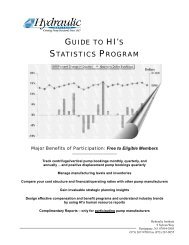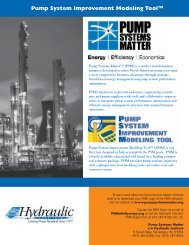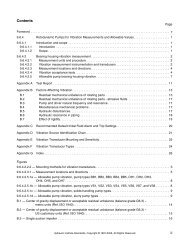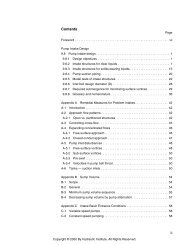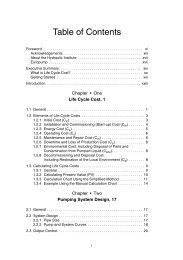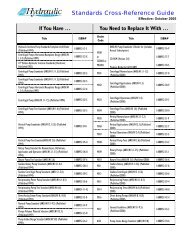High Efficiency Multiple Screw Pumps
High Efficiency Multiple Screw Pumps
High Efficiency Multiple Screw Pumps
You also want an ePaper? Increase the reach of your titles
YUMPU automatically turns print PDFs into web optimized ePapers that Google loves.
Three <strong>Screw</strong> <strong>Pumps</strong>:Principle ApplicationsThree screw pumps are the largest classof multiple screw pumps in service today.Typical applications include machinerylubrication, hydraulic elevators, fuel oiltransport, fuel oil burner service, powerhydraulics and refinery processes, such ashigh temperature viscous products includingasphalt, vacuum tower bottoms andresidual fuel oils.Three screw pumps also find extensiveuse in crude oil pipeline service (see Figure3A), as well as gathering, boosting and loading of barges andships. These pumps are also used for high pressure distillate fuelinjection for gas turbines.Designs are now available in sealless configurations, suchas magnetic drives and canned arrangements, to allow customersto reduce emissions and meet government guidelines. Threescrew pumps are renowned for their low noise levels, high reliability,ease of repair and long life (see Figure 3B).Figure 5. A power rotor with balance piston.Figure 4. Single and double suction three screw pumps.Design and OperationThree screw pumps are manufactured in two basic styles, singlesuction and double suction (see Figure 4). The single suctiondesign is used for low to medium flow rates and low to veryhigh pressure. The double suction design is really two pumpsin parallel in one casing, used for medium to high flow rates atlow to medium pressure.Three screw pumps generally have only one mechanicalshaft seal and one, or perhaps two, bearings that locate the shaftaxially. Internal hydraulic balance is such that axial and radialhydraulic forces are opposed and cancel each other. Thus, bearingloads are very low.Another common characteristic of three screw pumpsis that all but the smallest, low pressure designs incorporatereplaceable liners in which the pumping screws rotate. Minorrepair kits (seals, gaskets, bearing) and major repair kits (allwearing parts, including those in the minor repair kit) alloweasy field repair of most three screw pumps. So field repair is asimple matter and the piping does not have to be disturbed.The center screw, called the power rotor, performs all thepumping. The meshed outside screws, called idler rotors, causeeach liquid-holding chamber to be separated from the adjacentone, except for running clearances. This effectively allows stagingof the pump pressure rise. Because the center screw is performingall the pumping work, the drive torque transferred tothe idler rotors is only necessary to overcome viscous drag of thecylindrical rotor spinning within its liner clearance.The theoretical flow rate of these pumps is a function ofspeed, screw set diameter and the lead angle of the threads.Basically, flow rate is a function of the cube of the center screwdiameter. Slip flow is the volumetric inefficiency due to clearances,differential pressure and viscosity. It is a function of thesquare of the power rotor diameter, resulting in larger pumpsbeing inherently more efficient than smaller pumps. In crudeoil pipeline service, the power savings is greatest compared tocentrifugal pumps.Speed is ultimately limited by the applications/systemcapability to deliver flow to the pump inlet at a sufficient pressureto avoid cavitation. This is true of all pumps. Three screwpumps tend to be high speed pumps, not unlike centrifugalpumps. Two pole and four pole motors are most commonlyused.Slower speed may be necessary when dictated by largeflows, very high viscosities or low available inlet pressures. <strong>High</strong>speed operation is desirable when handling low viscosity liquidssince the idler rotors generate a hydrodynamic liquid film intheir load zones that resists radial hydraulic loads, very similarto hydrodynamic sleeve bearings found in turbomachinery.To achieve the highest pressure capability from three screwpumps, it is necessary to control the shape of the screws whileunder hydraulic load. Five-axis NC profile grinding accomplishesthis best, through complete dimensional control and ahigh degree of repeatability. Opposed loading of the idler rotoroutside diameters on the power rotor root diameter dictate thatthese surfaces be heat treated to withstand the cyclic stress.Again, profile thread grinding produces thefinal screw contour while leaving the rotors quitehard, in the order of 58R C . This hard surface betterresists abrasive wear from contaminants and extendsthe service life.Because some three screw pump applicationsrange to pressures of 4500-psi (310-bar), pumpingelement loading due to hydrostatic pressure can bequite high. With hydraulic balance, the forces are58 April 2007 www.pump-zone.com <strong>Pumps</strong> & Systems



